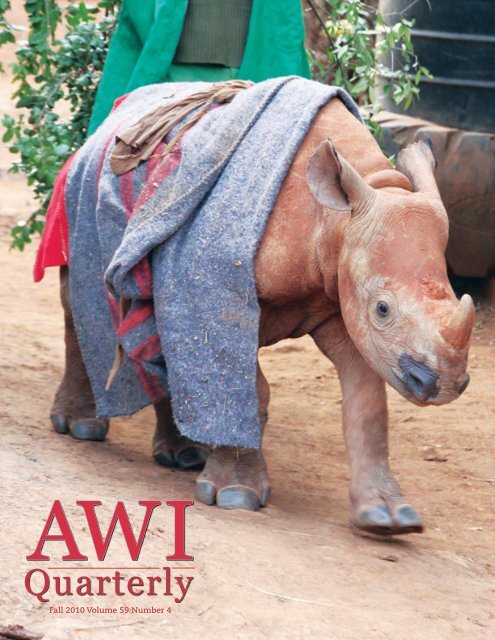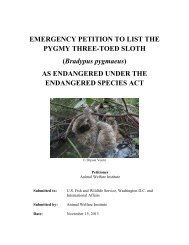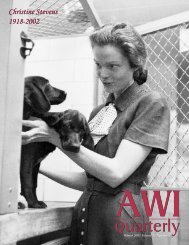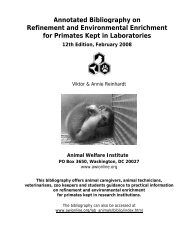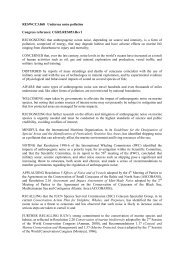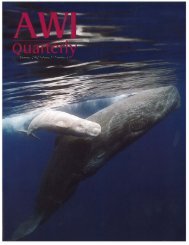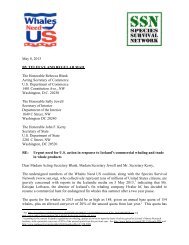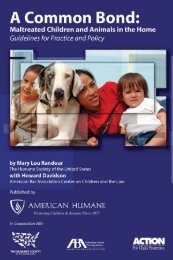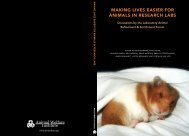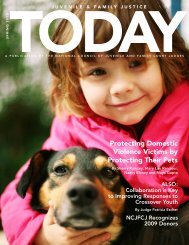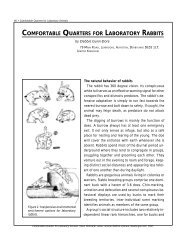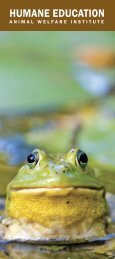Quarterly - Animal Welfare Institute
Quarterly - Animal Welfare Institute
Quarterly - Animal Welfare Institute
- No tags were found...
Create successful ePaper yourself
Turn your PDF publications into a flip-book with our unique Google optimized e-Paper software.
AW I<strong>Quarterly</strong>Fall 2010 Volume 59 Number 4
AWI<strong>Quarterly</strong>ABOUT THE COVERBaby black rhinoceros, Maalim, is heading in for his evening bottle and then a good night’sANIMAL WELFARE INSTITUTE QUARTERLYFOUNDERChristine Stevenssleep at the David Sheldrick Wildlife Trust outside Nairobi. Apparently abandoned by hismother, days-old Maalim (named for the ranger who rescued him) was found in the NguliaRhino Sanctuary and taken to the Trust. Now at 20 months, he has grown quite a bit but isDIRECTORSstill just hip-high! Black rhinos, critically endangered with a total wild population believed toCynthia Wilson, ChairBarbara K. BuchananJohn GleiberCharles M. JabbourMary Lee Jensvold, Ph.D.Cathy LissMichele Walterbe around 4,200 animals, continue to be poached (along with white rhinos) for their horns.“Into Africa” on p. 14 chronicles the visit to the Trust and other Kenyan conservation programsites by AWI’s Cathy Liss.Photo by Cathy Liss4OFFICERSCathy Liss, PresidentCynthia Wilson, Vice PresidentCharles M. Jabbour, CPA, TreasurerBrutal BLM RoundupsJohn Gleiber, SecretarySCIENTIFIC COMMITTEEGerard Bertrand, Ph.D.Roger Fouts, Ph.D.Roger Payne, Ph.D.Samuel Peacock, M.D.Hope RydenRobert SchmidtJohn Walsh, M.D.INTERNATIONAL COMMITTEEAline de Aluja, D.M.V., MexicoAmbassador Tabarak Husain, BangladeshAngela King, United KingdomAgnes Van Volkenburgh, D.M.V., PolandAlexey Yablokov, Ph.D., RussiaSTAFF AND CONSULTANTSNancy Blaney, Senior Federal Policy AdvisorCameron Creinin, Graphic Designer/IllustratorMichele Cunneen, Laboratory <strong>Animal</strong> ConsultantLucy Enniss, Executive AssistantCamilla Fox, Wildlife ConsultantChris Heyde, Deputy Director, Government and Legal AffairsDena Jones, Farm <strong>Animal</strong> Program ManagerAndrea Lococo, Wildlife ConsultantSusan Millward, Executive DirectorSerda Ozbenian, Wildlife Research AssociateAnnie Reinhardt, Information SpecialistViktor Reinhardt, D.M.V., Ph.D., Laboratory <strong>Animal</strong> AdvisorAva Rinehart, Senior Graphic DesignerJen Rinick, Research AssociateD.J. Schubert, Wildlife BiologistChristine Sequenzia, Federal Policy AdvisorTracy Silverman, General CounselMariko Terasaki, Wildlife Research AssistantRegina Terlau, Office CoordinatorDave Tilford, Writer/EditorDanielle Williams, Website and Communications CoordinatorFor subscription inquiries or other information,contact AWI at 900 Pennsylvania Ave., SE,Washington, DC 20003. Phone: (202) 337-2332;facsimile: (202) 446-2131. Email: awi@awionline.org,or visit AWI’s website: www.awionline.org.THE UNNECESSARY REMOVAL OF WILD HORSES has reached an alarming rateunder the current administration. Thousands of horses have been and continue tobe removed from their native range, and placed in short- and long-term holdingfacilities in theMidwest. Taxpayerspay tens of millionsof dollars a year towarehouse horseswho should beroaming free onpublic lands.Interior SecretaryKen Salazarannounced aplan supposedlyto improve BLM’smanagement whilesaving tax dollars.Unfortunately, itinvolved spendingmore money ($43 million in the first year alone) to buy land to warehouse morehorses. AWI opposed this plan and, thankfully, Congress rejected it. (Congress alsocut off another misguided “solution,” telling BLM that it could not use any funds toeuthanize healthy, adoptable horses.)A bipartisan letter signed by 52 members of Congress sent to Secretary Salazarquestioned the recent tragic deaths of several wild horses and focused on thedire need for an independent analysis of the wild horse and burro program bythe National Academy of Sciences (NAS). AWI started the national call for anindependent review of BLM’s practices regarding wild horses, and in one bit ofgood news, BLM has finally assented. In late August, BLM formally asked NAS tomake an independent technical review of the Wild Horse and Burro Program toensure that the agency is using the best science available in managing wild horsesand burros on Western public rangelands. The proposed study would tentativelybegin in January and take two years to complete. BLM, reprehensibly, has indicatedthe roundups will continue while the study goes on.BeforeHoney Bandit is a young foal snared in a summer 2010roundup near Twin Peaks, California. At two months of age,he was found in BLM custody near death—starving, severelydehydrated, separated from his mother, and covered with morethan 90 bite wounds from other horses. Rescued by PalominoArmstrong, he is making a miraculous recovery.Jennifer GillespieAfterLauri “Palomino” ArmstrongFall 2010 VOLUMEANIMALS IN LABORATORIES4 AWI to the Rescue! AWI JoinsForces with Shelters and RescueOrganizations to Save Hundreds of<strong>Animal</strong>s from Lab Under Investigationfor Abuse6 USDA Fines Vanderbilt for <strong>Animal</strong>Deaths in Lab18 New and Improved Guide for the Careand Use of Laboratory <strong>Animal</strong>sFARM ANIMALS22 Ferocious on the Field,Compassionate on the Pasture:NFL Football Star Will Witherspoon'sBiggest Win is the AWA Seal24 Humane Slaughter Laws:Enforcement up, but Still InsufficientMARINE LIFE6 Maui Regulates Pet Trade in Fish7 Palau and Honduras Call for MoreShark Sanctuaries21 Will Genetically Engineered SalmonSink or Swim?WILDLIFE106 Roadkill Research: Making HighwaysLess Hazardous8 The Massachusetts BeaverControversy10 Lead Poisoning: The Lessons of theBirds of Esperance14 Into Africa: AWI's Cathy Liss SeesConservation in Action in Kenya28 Escaped Snakes Lead to Jailfor Notorious Wildlife TraffickerCOMPANION ANIMALS7 Golf Course to Pay Owner forKilling Dog in TrapGOVERNMENT AND LEGAL AFFAIRS2 Brutal BLM Roundups17 Crush Videos17 Shark Finning17 B Dealers and NIH17 Horse Transportation17 Horse SlaughterREVIEWS2259 NUMBER 426 Two Books Examine OurRelationship with Wolves26 CAFO: The Tragedy ofIndustrial <strong>Animal</strong> FactoriesAWI PUBLICATIONS27 Kamie Cat's Terrible Night27 <strong>Animal</strong> <strong>Welfare</strong> PublicationsBookletAbove Left: Bald eagles in the nest.Every year, eagles and many other birdsare poisoned and killed by lead introducedinto the environment by humans. (Photoby Mark Wilson); Top Right: This beagleat a New Jersey shelter is one of roughly250 animals AWI helped rescue from anabusive lab in North Carolina.(Photo byAssociated Humane Societies ); BottomRight: Cows roam the pasture on WillWitherspoon’s AWA-certified Shire GateFarm in Owensville, Missouri. (Photo byAmelia J. Moore).
Rescued beagles—whoarrived earlier thatmorning—enjoy freshair and sunshine in thecompany of staffers atAssociated HumaneSocieties' Popcorn ParkRefuge in Forked River,NJ. At Popcorn Park,they are walked andsocialized every day.Associated Humane Societydramatic rescue occurred in September, whenCarolina. PLRS was funded by large pharmaceuticalscant three days to find shelter or have the animalscruelty. AWI is extremely grateful to PETA for itsnearly 200 dogs and over 50 cats were saved from acompanies to test insecticides and other chemicalsface possible euthanization. (All rabbits who were testinvestigation, to enforcement personnel at the USDANorth Carolina animal testing facility. The laboratoryused in companion animal products. For nine months,subjects at the facility were, in fact, euthanized.) Fromfor its prompt action once the situation was revealed,subsequently closed its doors after an undercovera PETA investigator worked undercover at the facility,Tuesday to Friday, AWI staff members franticallyand to the all the animal advocates who workedinvestigation documented abuse of the animals by workersand shot video showing animals in excruciatingovertime to get these animals placed in shelters.at the facility. Quick work on the part of the <strong>Animal</strong>pain from procedures, as well as employeesThrough the actions of many, hundreds of dogs and<strong>Welfare</strong> <strong>Institute</strong>, in partnership with the Humane Societykicking, throwing, and dragging petrified dogs,cats were rescued and given the chance to receive theof the U.S. and more than a dozen animal shelters andviolently slamming cats into cages, and screamingcare and compassion all animals deserve.” As we go torescue groups, succeeded in placing all of the rescuedobscenities at the animals for showing fear and beingpress, three quarters of the rescued annuals have beenanimals, offering hope that they will find loving homes anduncooperative. Workers even failed to move theadopted to "forever homes."solace after their ordeal.animals when they pressure sprayed the cage areas,People for the Ethical Treatment of <strong>Animal</strong>s (PETA)soaking them and splashing caustic chemicals onconducted the initial investigation 1 that exposed theapparent cruelty at Professional Laboratory and ResearchServices (PLRS), a rural lab located in Corapeake, Northalready painful open sores.“The exposure of this gratuitous crueltyunderscores the need for stricter enforcement toprotect animals in research facilities,” says AWIPresident, Cathy Liss. AWI has long worked to promotebetter care and handling of animals used in research,and foster efforts to provide them with the opportunityto engage in natural, species-typical behaviors, whileAssociated Humane Societies1More information on PETA’s investigation of the lab isavailable online at: www.peta.org/features/professionallaboratory-and-research-services.aspx.nimal shelters and/or rescues that havetaken in dogs and cats from the NC lab:::Dawn CruzDawn Cruz said,“We are so happythat Abby [adoptedfrom AssociatedHumane Societies]came into ourlives and that weare able to giveher a safe home,a soft bed, lots ofattention, and afamily that adoresher.” Pictured: Abbywith Dawn’s sons,Jonah (left) andBrandon.sparing them unnecessary pain, fear and distress.Following its investigation, PETA filed formalcomplaints with local, state and federal authorities,including the U.S. Department of Agriculture (USDA),and submitted evidence to the local prosecutor’s office.Soon thereafter, the USDA inspected the facility andinstigated a formal investigation—as did the localdistrict attorney’s office. In the meantime, the labagreed to surrender voluntarily its dogs and cats, and tocease research at the facility.The ordeal for the animals was not over, however.Alerted to the situation on a Tuesday, AWI was told thedeadline for placing the released animals was Friday—aNorth Star, one of six cats taken in by Associated HumaneSocieties, left her cage behind for the “Kitty City” freeroamingarea of the Societies’ Tinton Fall, NJ shelter.worked the phones, calling on AWI's vast networkand succeeding in getting all the dogs and cats placed.Over a dozen shelters and rescue groups from NewJersey to Florida were enlisted to take in the animals.While lamenting the situation that gave rise tothe rescue, Liss noted that in the present case, swiftaction saved lives: “This event serves as dramatictestament to what can happen when the humanecommunity comes together to expose and opposeloridaIn Dog We TrustNew JerseyAssociated HumaneSocietiesNorth CarolinaCarteret County HumaneSocietyGuilford County <strong>Animal</strong>ShelterSAFE Haven for CatsSPCA of Northeastern NorthCarolinaTriangle Beagle Rescue of NCWake County <strong>Animal</strong> CenterWake County SPCAVirginiaBeagles to the RescueElizabeth City SPCANorfolk SPCAVirginia Beach SPCAWashington, DCWashington <strong>Animal</strong>Rescue League4 AWI QUARTERLYFALL 2010 5
legislative · brieflyEducational CentersOur first stop at the Morani Information Centrein the Ol Pejeta Conservancy was the live exhibit:Baraka (whose name means "blessings" inKiswahili), a black rhino who has gone blind andcould no longer survive in the wild, is now caredfor in an enclosure beside the main building.There were many visitors, mostly children, whoappreciated the unique opportunity to be in suchclose proximity to a rhino as he was munching onhis lunch. Then we went indoors to the educationaland highly interactive exhibit rooms, with displayson the fauna and flora and the importance ofprotecting them.Equally impressive was the Giraffe Centre nearNairobi, with its own live exhibit: endangeredRothschild giraffes who roam the extensive groundsand are part of the breeding program responsiblefor helping to raise the population in Kenya to about300. This subspecies of giraffe is one of three foundin Kenya—the other two being the reticulated andthe Masai. Educational materials on giraffes andother wildlife are readily available at the Centre,whose walls are decorated with colorful works ofart by Kenyan children. Sales of the art help providedisadvantaged children the opportunity to visit theCentre and other places where they can learn totreasure their nation’s wildlife heritage.Larry Swetlow (photo of Giraffe Manor, adjacent to the Giraffe Centre)AWI CONTINUES to work with members of Congress to pass legislation to strengthen protection for animals.Some of our key areas of focus as the 111th Congress draws to a close are described below.CRUSH VIDEOSSome good news: The Senate unanimously passedlegislation, introduced by Senators Jon Kyl (R-AZ), JeffMerkley (D-OR), and Richard Burr (R-NC), to restore theban on crush videos (see Summer 2010 AWI <strong>Quarterly</strong>, p. 5).Some bad news: the Senate version differs from the bill theHouse passed in July, so now the House must vote again.That chamber did not take up the new bill before recessingfor the election, but there is a good chance that they willget to it when they reconvene next month.SHARK FINNINGDespite overwhelming support in the U.S. Senate for a billto close loopholes in a law banning the finning of sharks,Senator Tom Coburn (R-OK) took it upon himself to blockthis and several other responsible animal protectionbills at the last minute in an effort to make a point aboutgovernment spending. The House already approved thismeasure, so AWI will continue pressing the Senate to acton this bipartisan bill in November.Unless Congress acts, the production of crush videos willclaim more innocent animal lives.ACTION NEEDEDThese bills need your support! Visit www.awionline.org/takeaction or call AWI at(202) 337-2332 for information on how you canhelp by contacting your members of Congress.www.flickr.com/photos/captainsubtleThreats to wildlife continueto mount, including plans byTanzania to build a 260-mile roadbisecting the northern Serengeti,potentially jeopardizing the2 million wildebeests and zebrawho migrate from the Serengetiinto Kenya’s Masai Mara reservein search of water.Kenya’s FutureIt was heartening to see the clear value Kenya placesnot only on the education of tourists, but also on theeducation of its own people. From an early age manyKenyans have opportunities to learn the wonder ofnature—and the dangers that threaten it (i.e., theivory trade, bushmeat trade, human/wildlife conflicts,loss of range). Clearly, much energy is being investedin the future, with the hope that Kenya’s varied andbreathtakingly beautiful wildlife will survive to thebenefit of generations to come.All photos by Cathy Liss unless otherwise noted.Nathan SwetlowB Dealers and NIHHOUSE AND SENATE APPROPRIATIONS subcommittees haveagain expressed disappointment with the pace of efforts bythe National <strong>Institute</strong>s of Health (NIH) to end the purchaseof dogs and cats from random source Class B dealers by itsexternal grant recipients. The full Senate appropriationscommittee stated that the three- to four-year time frame NIHhas set for this phase out was “longer than the committeewould have preferred, especially considering that the NIHlargely ignored this issue for years.” NIH has been asked toupdate Congress on its progress in meeting this goal.Horse TransportationIN JULY, the House Committee on Transportationand Infrastructure unanimously approved the HorseTransportation Safety Act (H.R. 305). This bill would make itillegal to haul horses in trailers with two levels, one stackedon top of the other. The bill, sponsored by RepresentativesMark Kirk (R-IL) and Steve Cohen (D-TN), was introducedin response to several horrific accidents resulting in thedeaths of dozens of horses who had been crammed intounstable trailers.Horse SlaughterTHE ISSUE OF ENDING HORSE SLAUGHTER continues toresonate with Congress. Just before the House left forelection season, over 80 legislators from both partiessigned a letter circulated by Representatives Jim Moran(D-VA) and Elton Gallegly (R-CA), co-chairs of the House<strong>Animal</strong> Protection Caucus, to Speaker Nancy Pelosi askingher to bring H.R. 503—the Prevention of Equine CrueltyAct sponsored by Chairman John Conyers (D-MI) andRepresentative Dan Burton (R-IN)—up for a vote as soonas possible. Unfortunately, a vote was not held before theHouse recessed.16AWI QUARTERLYFALL 2010 17
Paul MullettNew and Improved Guidefor the Care and Use ofLaboratory <strong>Animal</strong>sA REVISED VERSION OF The National Research Council’sGuide for the Care and Use of Laboratory <strong>Animal</strong>s (theGuide) has been released as a pre-publication draft, thefirst revision of the Guide since 1996. The final publicationdate is December of this year. If only minor changes andtypographical corrections are incorporated in the finaledition, the 2010 version of the Guide is a step in the rightdirection by placing more emphasis on the quality of lifefor animals used in research.Why is this document important? The Guide is thereference manual animal research programs are supposedto adhere to if they receive National <strong>Institute</strong>s of Health(NIH) money or Small Business Administration (SBA)loans, are accredited by the Association for Assessmentand Accreditation of Laboratory <strong>Animal</strong> Care International(AAALAC), or are located in Cambridge, Massachusetts—where a laboratory animal ordinance requires adherence tothe Guide. In short, this document extends to most of theanimals used in research in the United States; therefore,the changes should impact millions of animals.D. SchatzbergUnder the Guide, it is typically the responsibilityof each institution to police itself, with limited directoversight. Accountability varies, depending on thejurisdiction: NIH's Office of Laboratory <strong>Animal</strong> <strong>Welfare</strong>(OLAW) administers the program for those researchprojects supported by taxpayer dollars; OLAW requiresan annual report and does not perform a site visit,except in some cases where there is direct evidence ofnoncompliance. AAALAC requires an annual report andconducts a scheduled site visit once every three years. TheCity of Cambridge carries out annual inspections.The 2010 Guide appears to embody a philosophicalshift from the perspective that enrichment, group housing,and social contact are “variables” that must be controlled,to an understanding that these elements can reducestress (itself a variable) and lead to more reproducibleresults (better science) while improving animal welfare.Previously, the standard called for animals to be singlehousedand their cages unenriched, unless you coulddemonstrate that group housing and enrichment would notnegatively impact scientific results. The standard set in theupdated Guide is that animals should be socially housedand their cages enriched. This change in emphasis shouldempower each institution’s Institutional <strong>Animal</strong> Care andUse Committee (IACUC) 1 and animal care staff to provideenrichment and social housing as standard housingconditions. Although the 2010 Guide states that facilities“should” rather than “must” use enrichment and socialhousing, it is unquestionably stronger in this regard thanthe 1996 edition. The following is a quote from the newGuide regarding the primary enclosure:All animals should be housed under conditions that providesufficient space as well as supplementary structures andresources required to meet physical, physiologic, andbehavioral needs. Environments that fail to meet theanimals’ needs may result in abnormal brain development,physiologic dysfunction and behavioral disorders (Garner2005; van Praag et al. 2000; Würbel 2001) that potentiallycompromise both animal well-being and scientific validity.The primary enclosure or space may need to be enriched toprevent such effects and improve animal well-being....An appropriate housing space or enclosure should alsoaccount for the animals’ social needs. Social animalsshould be housed in stable pairs or groups of compatibleindividuals unless they must be housed alone forexperimental reasons or because of social incompatibility....Structural adjustments are frequently requiredfor social housing (e.g., perches, visual barriers, refuges),and important resources (e.g., food, water, and shelter)should be provided in such a way that they cannot bemonopolized by dominant animals....The section on IACUC review of protocols is anotherarea where the 2010 Guide emphasizes animal well-being.Previous editions of the Guide focused on IACUC review ofwhat the project will do and what outcomes are expected.This edition has stated that the following additional itemsshould be considered in the protocol review:• Impact of the procedures performed on the animals’well-being;• Description and rationale for anticipated or selectedendpoints;• Criteria and process for timely intervention, removal ofanimals from a study, or euthanasia if painful or stressfuloutcomes are anticipated; andCreature comforts for these cats includegroup housing and carpeted perches.• Method of euthanasia or disposition of animal, includingplanning for care of long-lived species following studycompletion.The Guide goes on to state:While the responsibility for scientific merit reviewnormally lies outside the IACUC, the IACUC shouldevaluate scientific elements of the protocol as they relateto the welfare and use of the animals.When considering certain animal use protocols withthe potential for unrelieved pain and distress, the 2010Guide further delineates:…the IACUC is obliged to weigh the objectives of the studyagainst potential animal welfare concerns. By consideringopportunities for refinement, the use of appropriate nonanimalalternatives and the use of fewer animals, boththe institution and the Principal Investigator can begin toaddress their mutual obligations for humane animal careand use.Page 18, Left to Right: A squirrel monkeyengages in natural behavior by workingto obtain food from a complex feeder. Apaper hut and nesting materials provideenrichment for a nude mouse.1The Institutional <strong>Animal</strong> Care and Use Committee (IACUC) is a selfregulatingentity that, according to U.S. federal law, must be establishedby institutions that use animals for research or instructional purposes, tooversee and evaluate all aspects of the institution’s animal care and useprogram. For more information, see www.iacuc.org.Michele Cunneen18 AWI QUARTERLYFALL 2010 19
Taken together, these additions obligate theresearchers to provide more detail about their projects. Insome cases this will require pilot studies to obtain data theywere previously not required to collect about effects on theanimals. Many IACUCs, with strong institutional support,have requested and reviewed this type of information foryears. However, IACUCs that were unable to get thesedetails in the past can now ask for them irrespective ofinstitutional support.Many other areas of the 2010 Guide have beenexpanded to provide more direction to the researchers,IACUCs, and animal care staff regarding endpoints,humane endpoint is the point at which pain or distressis prevented, terminated or relieved in an experimentalanimal. The use of humane endpoints contributes torefinement by providing an alternative to experimentalendpoints that result in more severe animal pain anddistress, including death. The humane endpoint should berelevant and reliable.Prior to this edition of the Guide, it was not clearthat the veterinarian was the ultimate authority in theevaluation of an ill animal. Now, there is no ambiguity:In the case of a pressing health problem, if the responsibleperson (e.g., investigator) is not available or if consensusbetween the investigator and veterinary staff cannot bereached concerning treatment, the veterinarian must havethe authority, delegated by senior administration (seeChapter 2, Institutional Official and Attending Veterinarian)and the IACUC, to treat, remove from the experiment,institute appropriate measures to relieve severe pain orWill Genetically EngineeredSalmon Sink or Swim?IN A CHILLY HOTEL BALLROOM IN THE WASHINGTON, D.C.suburbs this September, the Food and Drug Administration(FDA) heard from the public on the question of whethera farm-raised Atlantic salmon named “AquaAdvantage”should be approved as the first genetically engineered (GE)food animal. AquaAdvantage salmon contain a growthhormone gene from Chinook salmon that allows them togrow faster and reach market sooner than conventionallyfarmed Atlantic salmon.the precedent set by other countriesand U.S. consumers’ preference forlabeling, the FDA has indicated thatlabeling will be based on a narrowview of material differences in GEsalmon compared to non-GE salmon.Industry groups and consultants,including Richard Carnevale of<strong>Animal</strong> Health <strong>Institute</strong>, were quickdistress or euthanize the animal if necessary.The FDA is considering four main questions forto repeat the platitude that there wereGroup housing for these chickens is enrichedwith hay bales and travel crates for perchesand hiding.authority to euthanize, use of Class A dealers, andthe inclusion of aquatic and terrestrial animals in thediscussion of housing and care.In many research protocols, the endpoints have beenill-defined both by the regulations and by the researchersthemselves. This Guide provides both a definition and arequirement for reliability:Michele CunneenWhile still not condemning Class B dealers, a newsection titled “<strong>Animal</strong> Procurement” suggests the IACUCmust approve the source and number of animals, and thereis now a clear preference for Class A dealers:…vendors of purpose-bred animals (e.g., USDA Class Adealers) regularly provide information that describes thegenetic and pathogen status of their colonies or individualanimals and relevant clinical history, for example,vaccination status and anthelmintic administration. Becauseof this, the use of purpose-bred and pre-conditionedanimals is preferable when consistent with the research,teaching and testing objectives.Zebrafish, African clawed frogs, and other nontraditionalanimals used in research, not considered inprevious editions, are now included; definitions for careand housing of these species, as well as suggestions fordesign of facilities and enrichment of these species isdelineated. While still general, the information startsto put these species into the professional care and usestandards expected for the animals more traditionally usedin research.Overall, the 2010 Guide reflects a substantial shifttowards recognizing the importance of the animal as ananimal, not just another test tube in research.AquaAdvantage salmon approval: salmon health, foodsafety, environmental impact, and the product claimsof increased growth. What FDA is not considering in itsdecision leaves some doubt as to the rigor and scope ofthe GE animal approval process. The FDA is not assessingthe food safety of the whole fish by conducting feedingstudies, but merely assessing the component parts of thefish without looking at cumulative risks. The FDA is notconsidering ethical arguments against genetic modification,or the broader social context of GE. Ecological problemscaused by GE salmon escaping and interbreeding, orcompeting with wild salmon are of concern as well, andrequire more study. <strong>Animal</strong> welfare will not be consideredduring the AquaAdvantage approval process, either, asadmitted by one FDA staff member at the hearing.At the same series of public hearings, FDA alsodiscussed labeling of food animal products. Patty Lovera ofFood and Water Watch argued in the public hearing that,if approved, GE salmon should be the first food required tocarry a GE label. Gregory Jaffe from the Center for Sciencein the Public Interest cited that 70 percent of Americanconsumers want GE food to be labeled. There are 62genetically modified crop varieties in the U.S. food supply,as reported in 2002 by the U.S. Department of Agriculture(USDA), and none are currently required to be labeled asno material reasons GE salmon shouldbe labeled. Richard Clothier, chairman ofthe AquaBounty Technologies companythat developed the AquaAdvantage salmon,rejected mandatory labeling as a “slippery slope” leadingto labeling of all GE foods. Alison Van Eenennaam, ofthe University of California Cooperative Extension at UCDavis, proposed yet another line of arguments that geneticengineering is a production method, and productionmethods are too difficult to spell out on a label. This laststatement seems to be at odds with both USDA organiclabeling, which is a production method, and the risingconsumer interest in how food is raised.Observers speculate that AquaAdvantage salmon mayeventually be approved and reach the market, though it isunclear whether it will be labeled as genetically engineered.The popularity of salmon in the U.S. and the trend ofincreasing farmed salmon production globally meansthat consumers, and not regulators, will make the finaldecision on GE salmon—that is, if they know what they arebuying. It remains to be seen if the FDA is limber enough tomodernize its GE animal labeling and approval processes tokeep pace with consumer awareness of GE issues and thecoming migration of animals from the lab to the farm.Illustration by Cameron CreininThe experimental endpoint of a study occurs when thescientific aims and objectives have been reached. TheBy Michele CunneenLaboratory <strong>Animal</strong> Consultantsuch. The U.S. position on GE labeling runs counter tothat of many other countries—since the late 1990s andearly 2000s, labeling of GE foods has been required in theBy David Love, Ph.D., Aquaculture Project DirectorJohns Hopkins Center for a Livable FutureEuropean Union, Australia, Japan and South Korea. Despite[portions of this piece were reproduced from posts on the LivableFutureblog.com]20AWI QUARTERLYFALL 2010 21
Compassionate on the PastureFerocious on the Field,NFL Football Star Will Witherspoon’s Biggest Win is the AWA SealFOOTBALL IS AMERICA’S TOUGHEST major professionalsport. Its players are renowned for their size, strength,agility and laser-like focus—as well as their ability to giveand receive bruising, bone-wrenching, gut-busting hits andtackles. A professional football game is an hour-long (by thetime clock) display of strategy, finesse, and aggressive brutestrength. Conversely, no one would characterize farming asa show of aggressive brute strength and fierce competition.The two worlds—the controlled violence of football and thepatient caretaking of farming—seem light years apart.That’s the point, says Will Witherspoon, a linebackerfor the Tennessee Titans and owner of Shire Gate Farm inmy kids, and all kids really, to grow up in a way that isOwensville, Missouri. Witherspoon relishes the lush greenmore in touch with the natural environment. Witherspoonpeace of Shire Gate and the respite it provides to him, hissays he chose the White Park breed of cattle for his farmwife Rebecca, and daughters Layne, Maya and Shaye, in thein part because they thrive in a grassfed environment. "Myoff-season. “Shire Gate is a total escape for us,” Witherspooncattle are raised as nature intended, on grass, and aren’t fedphotos by Amelia J. MooreTop: Family photo: Will Witherspoon,his wife Rebecca, daughters Layne, Maya and Shaye,and one of the Witherspoon dogs. Bottom: Will’s father, Cordell“Pops” Witherspoon, tends to the animals. A former military officer,Cordell now lives on the farm.says. “It’s a place where my daughters and I can work withthe animals and the land. I use the companionship of theanimals and the beauty of the land to refocus myself afterthe demands of playing football. Shire Gate is our retreatfrom the world.”Witherspoon purchased Shire Gate Farm in 2007 as ahome for his Shire horses, Rocky and Simon. As the farmexpanded to include more horses, Witherspoon decided toturn Shire Gate into a working farm and added cows and(more recently) pigs. His research led him to AWI’s <strong>Animal</strong><strong>Welfare</strong> Approved (AWA) program and pasture-basedfarming. The AWA program—at no cost to the farmers—audits and certifies family farms that prioritize the wellbeingof the animals. “I wanted Shire Gate Farm to be trueto nature and true to the way things should be done,”Witherspoon says. “That means putting the welfare andcare of the animals first.”As a professional athlete in a highly physical andcompetitive sport, Witherspoon is especially aware of thehealth benefits of grassfed, high-welfare farming. “I wantgrowth hormones, antibiotics or other unnatural additives,”he says. Raising his cattle according to AWA programstandards is how Witherspoon shows his commitmentto animal welfare on his farm. “The great thing aboutthe program is that it offers a wealth of information andprovides access to people who can help me raise my herdand build my farm. There’s no way I can go wrong. I knowthat AWA and AGA [American Grassfed Association] willwork alongside me as Shire Gate grows.”Witherspoon also owns two dog daycare centers,another opportunity to provide humane care of animals.“I bought a farm for my horses and daycares for my dogs,”he jokes. “So raising my cattle on pasture is a given.” On amore serious note, Witherspoon has seen the benefits ofpasture-based farming for his livestock. “I’ve only had onecalf that has really been sick; otherwise my herd is veryhealthy. No hoof issues, no pink eye—you can’t argue withsuccess like that.”AWA Program Director Andrew Gunther praisesWitherspoon’s dedication to raising his animals withShire Gate livestock grazing on pasture, enjoying both the open spaceand the company of each other.high-welfare standards. “When I visited Shire Gate withAmerican Grassfed Association President Dr. PatriciaWhisnant, it was clear he brings to his farm the sameintense attention to detail and preparation he brings tothe football field.” In addition to his wife and daughters,Witherspoon’s father, a former military officer, also resideswith him at Shire Gate Farm. According to Gunther, “Itwas clear this is not just an infatuation for Will, but a realworking family farm that will grow and prosper.”Fierce on the field, Witherspoon is equally fierce aboutthe welfare of his animals. “When I decided to bring cattleand other animals on the farm, I jumped in quite readilyand I decided if I’m going to do it, I’m going to do it right.AWI is helping me achieve that goal.”22 AWI QUARTERLYFALL 2010 23
HUMANE SLAUGHTER LAWS:ENFORCEMENT UP, BUT STILL INSUFFICIENTA NEW REPORT, Humane Slaughter Update: ComparingState and Federal Enforcement of Humane SlaughterLaws, has just been published by the <strong>Animal</strong> <strong>Welfare</strong><strong>Institute</strong>. According to the report, nearly three years afterthe shocking exposé of inhumane practices at a Californiapacking plant, enforcement of humane slaughter laws hasincreased at both the state and federal levels, but remainslow and inconsistent. Furthermore, the mild nature of thepenalties (plant closures amounting to a few days or less)are insufficient to deter repeat violators from continuing tocommit inhumane acts.In late 2007, an undercover animal welfare advocatecaptured on video multiple incidents of egregious crueltyto cattle at the Westland-Hallmark Meat Packing plantin Chino, California. The video showed workers kicking,shocking and abusing animals too sick or injured to walkinto the slaughterhouse, even shoving them with forklifts.Brought to the attention of enforcement officials and thepublic in early 2008, the incident sparked widespreadpublic outrage, caused criminal charges to be filed againsttwo of the employees, and led to the largest beef recallin U.S. history. Sadly, these incidents occurred despitethe continual on-site presence of U.S. Departmentof Agriculture (USDA) inspection personnel and theperformance of periodic third-party humane slaughteraudits at the plant.The Humane Methods of Slaughter Act requires thatmeat animals, excluding birds and rabbits (as well asanimals slaughtered in accordance with religious law),be made insensible to pain by a single blow, gunshot,or electrical or chemical means before being shackled,hoisted or cut. The law also provides for the humanehandling of animals on the premises of a slaughterhouse.The law applies at slaughter establishments inspectedby the USDA, or in some cases by state departmentsof agriculture—which have the authority to take action(including the issuance of noncompliance records,suspensions, and withdrawal of inspection) for violationsof the federal humane slaughter law.Congress held multiple oversight hearings in the wakeof the Westland-Hallmark incident, and the USDA tookseveral actions to step up its enforcement of the HumaneMethods of Slaughter Act, including conducting an auditof slaughter plants at high risk for humane violations,temporarily increasing the time spent verifying humanehandling and slaughter requirements, and issuing varioushumane slaughter notices and training modules for inplantinspection personnel.To judge the effectiveness of these measures andto update a comprehensive, ten-year review of humaneslaughter enforcement published by AWI in May 2008, 1AWI conducted a survey and analysis of state andfederal humane slaughter enforcement since Westland-Hallmark, using data obtained through state publicrecords, federal Freedom of Information Act (FOIA)requests, and information posted on the USDA website.Among AWI’s findings:Repeat state and federal violators present a majorenforcement problem. Numerous examples of repeatviolators were found, including a Wisconsin state plantthat was cited for humane violations 34 times in 20months, and a North Carolina federal plant that was closeddown eight times in 30 months for incidents of inhumaneslaughter. The percentage of state plants with multipleviolations from 2007 to 2009 was up over the previouslystudied period of 2002 to 2004. At the federal level, thelength of time that slaughter plants were shut down forhumane violations varied by plant size, with very smallplants being closed for the longest periods of time andlarge plants being closed for the shortest time.State and federal inspection personnel haveinadequate training in humane enforcement andinadequate access to humane slaughter expertise.Enforcement documents reveal that inspectors reactdifferently when faced with similar humane handlingviolations. Federal inspectors have limited access tohumane slaughter experts, while states known to employ1D Jones, Crimes without Consequences: The Enforcement ofHumane Slaughter Laws in the United States, <strong>Animal</strong> <strong>Welfare</strong><strong>Institute</strong>, May 2008. www.awionline.org/cwc.veterinary humane slaughter specialists generally havehigher enforcement rates. Federal inspectors are aboutfour times more likely than state inspectors to suspenda slaughter plant for a humane handling violation (liketaking multiple attempts to stun an animal, cutting a stillconsciousanimal, or dragging a non-ambulatory animal).State and federal humane slaughter enforcementwas up at both state and federal levels but variedwidely among individual states and amongindividual federal districts. Enforcement was upin terms of the issuance of noncompliance records andsuspensions at state inspected plants and suspensionsat federal plants. The number of federal slaughterhousesuspensions for humane violations increased seven-foldfrom 2006-2007 to 2008-2009 (as depicted in the chartbelow). State suspensions were up sharply as well. However,some states offered no evidence of any enforcementwhatsoever, and humane activities differed dramaticallyamong the 15 federal food safety enforcement districts.Humane enforcement remained low incomparison with other aspects of food safetyenforcement. While allocation of resources to humaneslaughter activities appears to have increased for stateplants, the amount of time spent at federal plants onhumane activities appears to be unchanged. Overall,resources devoted to humane handling at the federal levelcontinues to be less than 2 percent of total funding for foodsafety inspection.Based on our analysis, AWI has offered the USDAseveral recommendations for improving the enforcementSUSPENSIONS100806040200of humane slaughter laws. Most importantly, AWIis requesting longer suspensions and more frequentwithdrawal of inspection (plant closure) for repeatviolators. AWI is recommending that, upon a secondincident of inhumane handling, a plant be closed for aminimum of 30 days, and that inspection services bewithdrawn for a period of at least three years after a thirdincident of animal abuse.In addition, AWI has recommended that the USDAdevelop procedures for referring instances of animalcruelty during slaughter to state or local law enforcementofficials for prosecution under anti-cruelty statutes, andthat the USDA work to achieve greater consistency inhumane slaughter enforcement among state-level meatinspection programs.Finally, AWI has asked that the USDA makeslaughterhouse enforcement records available to the publicvia posting on the agency’s website. Posting informationregarding slaughter plant compliance with humaneslaughter laws and regulations would assist the public inmaking informed decisions about the foods they purchaseand consume, and would pressure individual slaughterplants to abide by the humane slaughter law.Until the USDA makes these records readily availableto the public, a list of slaughter plants that have beensuspended for humane violations (including, in some cases,actual enforcement documents) is available on the AWIwebsite at www.awionline.org/humaneslaughterviolations.Also available on the site is the full report: HumaneSlaughter Update.Federal Suspensions by Year, 1998-200998 99 00 01 02 03 04 05 06 07 08 09YEAR24 AWI QUARTERLYFALL 2010 25


